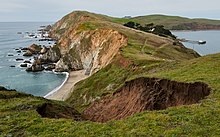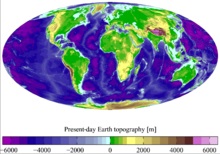|
|
| |
|
|
| |
|
|
|
|
| |
 |
| Land between bodies
of water at Point Reyes National Seashore,
California. |
Land
Land is the solid surface of the Earth that is not
permanently covered by water. The vast majority of human
activity throughout history has occurred in land areas
that support agriculture, habitat, and various natural
resources. Some life forms, including terrestrial plants
and terrestrial animals, have developed from predecessor
species that originated in bodies of water.
Areas where land meets large bodies of water are called
coastal zones. The division between land and water is a
fundamental concept to humans. The demarcation line
between land and water can vary by local jurisdiction
and other factors. A maritime boundary is one example of
a political demarcation. A variety of natural boundaries
exist to help clearly define where water meets land.
Solid rock landforms are easier to demarcate than marshy
or swampy boundaries, where there is no clear point at
which the land ends and a body of water has begun.
Demarcation lines can further vary due to tides and
weather. |
|
 |
| Map showing Earth's
land areas, in shades of green and yellow. |
History of land on Earth
The earliest material found in the Solar System is dated
to 4.5672±0.0006 bya (billion years ago); therefore, the
Earth itself must have been formed by accretion around
this time. By 4.54±0.04 bya, the primordial Earth had
formed. The formation and evolution of the Solar System
bodies occurred in tandem with the Sun. In theory, a
solar nebula partitions a volume out of a molecular
cloud by gravitational collapse, which begins to spin
and flatten into a circumstellar disc, which the planets
then grow out of in tandem with the star. A nebula
contains gas, ice grains and dust (including primordial
nuclides). In nebular theory, planetesimals commence
forming as particulate matter accrues by cohesive
clumping and then by gravity. The assembly of the
primordial Earth proceeded for 10–20 myr. |
|
Earth's atmosphere and oceans were formed by volcanic
activity and outgassing that included water vapor. The
origin of the world's oceans was condensation augmented
by water and ice delivered by asteroids, proto-planets,
and comets. In this model, atmospheric "greenhouse
gases" kept the oceans from freezing while the newly
forming Sun was only at 70% luminosity. By 3.5 bya, the
Earth's magnetic field was established, which helped
prevent the atmosphere from being stripped away by the
solar wind. The atmosphere and oceans of the Earth
continuously shape the land by eroding and transporting
solids on the surface.
The crust, which currently forms the Earth's land, was
created when the molten outer layer of the planet Earth
cooled to form a solid mass as the accumulated water
vapor began to act in the atmosphere. Once land became
capable of supporting life, biodiversity evolved over
hundreds of million years, expanding continually except
when punctuated by mass extinctions. |
|
|
The two models that explain land mass propose either a
steady growth to the present-day forms or, more likely,
a rapid growth early in Earth history followed by a
long-term steady continental area. Continents formed by
plate tectonics, a process ultimately driven by the
continuous loss of heat from the Earth's interior. On
time scales lasting hundreds of millions of years, the
supercontinents have formed and broken apart three
times. Roughly 750 mya (million years ago), one of the
earliest known supercontinents, Rodinia, began to break
apart. The continents later recombined to form Pannotia,
600–540 mya, then finally Pangaea, which also broke
apart 180 mya. |
|
|
|
|
|
|
|
|
|
|
|
|
|
|
|
|
|
|
Search Fun Easy English |
|
|
|
|
|
|
|
|
|
|
|
|
|
|
|
About
Contact
Copyright
Resources
Site Map |